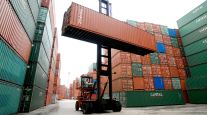Intermodal Freight Up 4.7%; Total Shipments Top 4 Million
This story appears in the Nov. 11 print edition of Transport Topics.
The growth of intermodal traffic accelerated in the third quarter, rising 4.7% to 4.01 million shipments, powered by a combination of improved domestic and international freight trends, the Intermodal Association of North America reported last week.
The trade group’s third-quarter report showed domestic shipments rose 7.6% over the 2012 quarter to 1.97 million, exceeding the 6.5% growth pace in the second quarter. International shipments resumed their growth, climbing 2% over the 2012 period to 2.04 million after a 1.3% decline in the April-to-June period.
“After an unpredictable second quarter, intermodal regained some traction in the third quarter,” IANA said in its Nov. 1 report. “Volumes dropped in June, creating some concern for future weakness in intermodal markets. This concern was alleviated by three months of strong third-quarter growth.”
On a combined basis, domestic and international shipments topped the comparable month of 2012 by 5% in July, 4% in August and 6% in September, the report showed.
However, August international loads trailed the same month of 2012 by 0.5% before rebounding to post growth of 5.1% in September, highlighting the volatility of that market, the report said.
Larry Gross, senior consultant at FTR Associates and a former intermodal industry executive, told Transport Topics the improved results for September are inflated because of industry events dating to August 2012.
In that month, shipments rose in advance of the scheduled Sept. 30 expiration of a contract covering dockworkers at East Coast and Gulf Coast ports. That contract was extended multiple times before it was ratified in April.
Both Gross and IANA’s report highlighted the continued growth of domestic truck/rail freight.
“The most important story is that freight is successfully converted to intermodal,” Gross told TT.
Gross said domestic intermodal shipments moving more than 550 miles continue to increase and gain market share from the highway.
“Domestic container shipments continued to dominate intermodal growth,” IANA’s report said. Those shipments increased 9.4% in the quarter, while trailer shipments of domestic freight gained 1.2%. Container freight accounts for about 80% of domestic truck/rail cargo.
Gross and the IANA report said the outlook for intermodal remains uncertain for multiple reasons.
“The key question is where the underlying demand for transportation is going to land,” Gross said. “In order to predict where intermodal is going, you have to be able to predict where the economy is going. Our view is that the economy is going to poke along.”
An important unknown, he said, is what actions might be taken in Washington that would affect the broad economy.
He did express confidence that domestic intermodal will continue to gain business that previously moved solely over-the-road.
“Looking forward to both late 2013 and next year, it is difficult to estimate overall intermodal growth, given international’s unpredictability,” the report said.
“It looks like full-year 2013 growth will come in close to 4%, consistent with year-to-date performance. A similar pace appears likely for 2014 as well, assuming the economy continues its marginal performance,” IANA said.
Also included in the IANA report is information from FTR statistics on trucking shipments, showing a 6% increase in freight loads in the third quarter.
“Although the last two years have not produced the dramatic quarters found in most upturns, average growth [in truck shipments] has been over 5%,” the report said, citing FTR data.
The IANA report also said that intermodal marketing companies’ performance improved in the third quarter, both on a sequential and year-over-year basis.
Intermodal loads were 5.3% above last year’s third quarter and 3.1% better than the second quarter.




